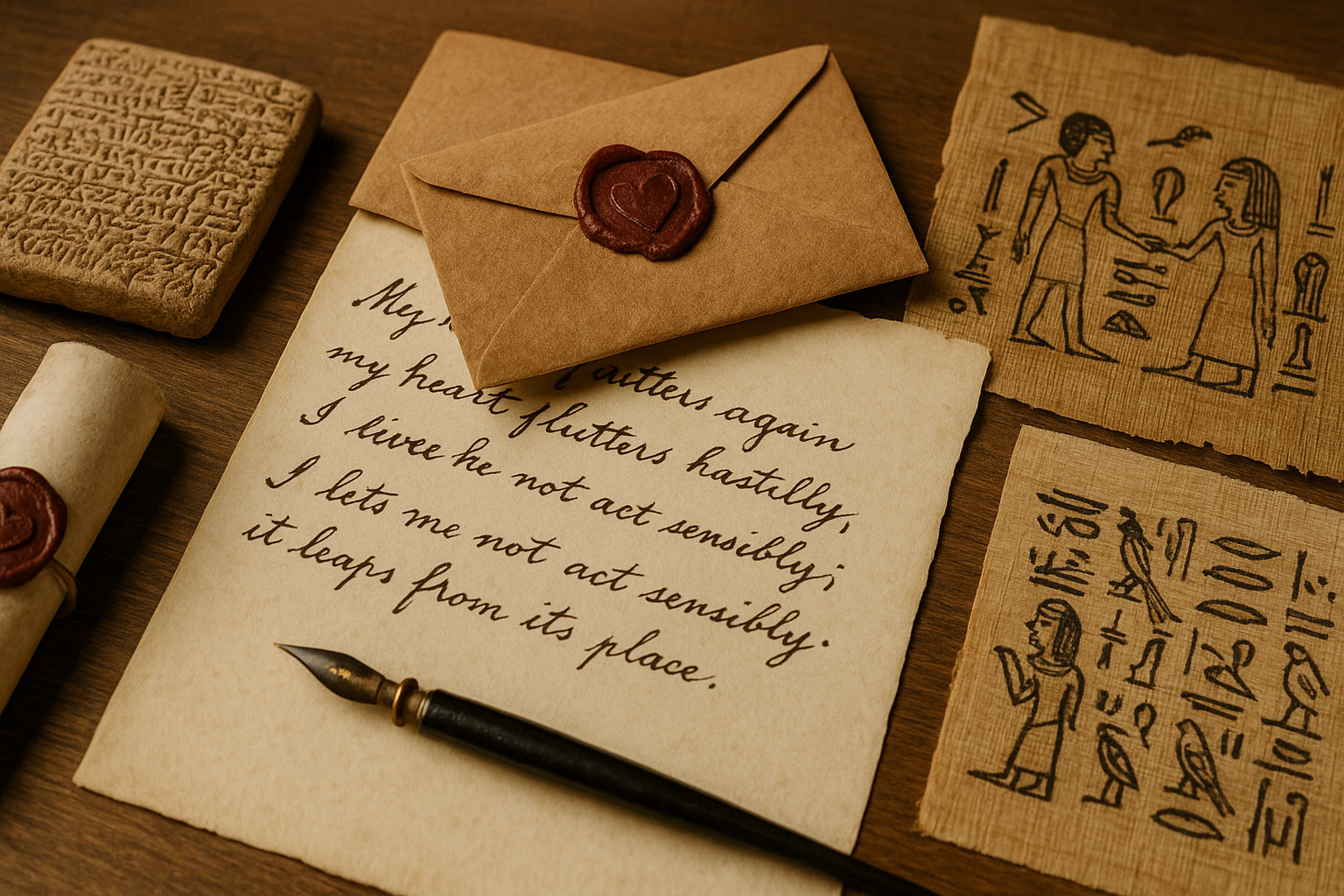Love letters did not begin with Shakespeare or Victorian courtships. They go back much further—inscribed in clay, inked on papyrus, or etched into memory through oral traditions. Ancient civilizations wrote with rawness, sincerity, and formality that both preserved and honored their desire. What did love look like when writing meant chiseling stone or unfolding a parchment sealed with wax? The answers lie in the words of ancient lovers.
1. Mesopotamia: Etched in Clay, Steeped in Ritual
In the cradle of civilization, the Sumerians and Akkadians wrote love letters on clay tablets in cuneiform. These early letters mixed personal longing with religious tone. Many served ritual purposes, used in sacred marriage ceremonies or divine courtship reenactments.
Example from a Sumerian tablet (c. 2000 BCE):
“Bridegroom, dear to my heart,
Goodly is your beauty, honeysweet.
Lion, I would be taken by you into the bedroom.”
These were not private whispers—they were meant to invoke fertility, prosperity, and divine favor. Personal intimacy intertwined with community life.
2. Egypt: Passion Beneath the Papyrus Moon
Ancient Egyptians crafted poetic declarations that blurred the line between metaphor and confession. Love letters here were rich in imagery and desire. Whether painted on tomb walls or written on scraps of papyrus, their purpose was clear—yearning expressed with elegance.
Common themes:
- The scent of the beloved compared to lotus blossoms
- Love described as sickness or intoxication
- Desire restrained by societal roles, but unhidden in words
Excerpt from an Egyptian love poem (New Kingdom, c. 1300 BCE):
“My heart flutters hastily when I think of you.
It lets me not act sensibly; it leaps from its place.”
Men and women alike wrote such lines, revealing an openness about love, longing, and heartbreak that rivaled any modern expression.
3. India: Sanskrit, Seduction, and Sacred Devotion
Ancient Indian texts offered layered perspectives on love—erotic, romantic, spiritual. Letters were often poetic in form, drawing from Sanskrit traditions. The Kāma Sūtra itself includes guidance on how to write letters of courtship.
Love letter categories in the Kāma Sūtra:
- Letters from a woman to a man of higher status
- Letters of complaint about separation
- Coded letters for forbidden or secret love
Example structure:
- Introduction praising the virtues of the beloved
- Body with emotional reflection
- Closing with a plea for reunion or acknowledgment
This codification did not limit affection; it enriched the emotional vocabulary of lovers across caste and class.
4. Greece: From Mythic Desire to Literary Confessions
Love letters in ancient Greece were theatrical, philosophical, and emotionally piercing. Plato wrote about love as divine madness. Sappho wrote lyrical verses to unnamed female companions. Later, Roman-era Greeks like Philostratus penned fictional epistles exploring the torment of desire.
Themes that dominated:
- Love as fate or punishment
- Rejection and jealousy
- The lover as student to the beloved’s beauty
In fiction, letters often became dramatic tools—an absent voice crying out across distance or war.
5. Rome: Flattery, Wit, and Letters of Seduction
Romans elevated love letters to an art of wit and timing. Letters reflected the passion of poets like Ovid, who offered instruction in the Ars Amatoria on how to win affection through words.
Key tactics in Roman love letters:
- Use of flattery without excess
- Embedding mythological references
- Balancing lust and decorum
From Ovid’s Heroides:
“I read your letter again and again,
kissing the line where your name appears.”
The tone ranged from earnest to strategic. Love was pleasure, but also performance. Letters were often a game where sincerity had to wear elegance like armor.
6. China: Ink-Stained Elegance Behind Silk Screens
In ancient China, love letters carried delicacy and metaphor. Whether from Confucian scholars or hidden court ladies, they reflected restraint, yearning, and literary polish.
Customs that shaped love writing:
- Use of classical poetry forms
- Avoidance of direct expression of desire
- Inclusion of seasonal or natural imagery (willow branches, moonlight, plum blossoms)
A scholar might write:
“The autumn wind carries your name across my sleeve.
Though we are apart, my ink still warms your touch.”
Calligraphy mattered. The brush stroke became part of the message. The letter was not just content but presence.
7. Japan: Courtship by Poetry
During the Heian period (794–1185), love letters flourished as waka poems exchanged between aristocrats. A well-written letter could determine a relationship’s fate. Style trumped status.
Typical structure:
- Folded letter perfumed and wrapped
- Waka poem (31 syllables) with veiled reference to a recent event or dream
- Symbolic plant or flower attached for added message
From Lady Murasaki’s The Tale of Genji:
“Though I sleep alone
My sleeve is damp from dreaming
Of the touch of you.”
Subtlety was praised. Repetition was expected. Lovers wrote in layers, each word chosen for sound, stroke, and suggestion.
8. Maya Civilization: Codices and Carved Pleas
Though many original texts were destroyed, remnants suggest that love among the Maya was linked to court rituals and dynastic marriages. Glyphs in codices and inscriptions sometimes reflected intimate messages—especially among nobles.
Carvings on stelae and ceramics included references to beauty, longing, and even gifts exchanged between rulers and consorts. Pictorial writing made these letters both message and monument.
What They All Share
Across continents and eras, ancient love letters reveal:
- Desire framed by custom
- Poetry over plain prose
- Longing in absence as a dominant theme
- Language as bridge, not closure
Even without emojis or instant replies, ancient lovers found ways to express urgency, pain, admiration, and hope. Their letters were not just communication—they were preservation of connection across time and space.
For those studying love today, these ancient voices show that sincerity, not speed, leaves the deepest mark.
